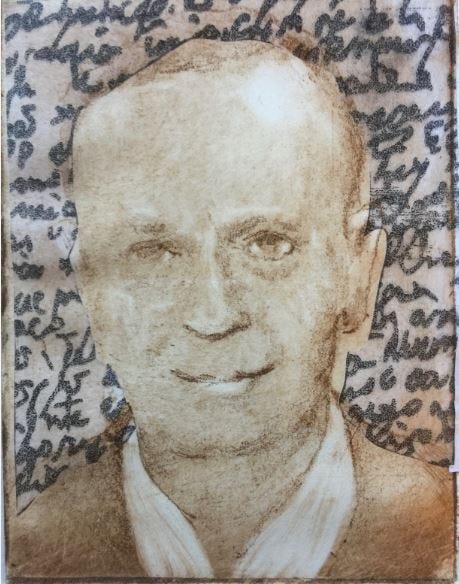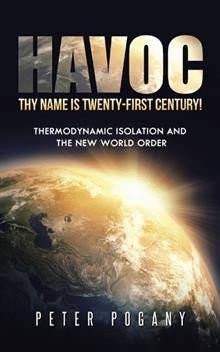Drifting Toward a New Form of Self-Organization
The Legacy of Peter Pogany
Beginnings and Endings are hard.
My first Substack post. Where do I start?
1. Why this, why now
Let’s start with Peter Pogany. Today happens to be the 10th anniversary marking the passing of Peter Pogany from this fair orb on May 25, 2014. A lot has happened in the intervening 10 years since his passing, but Pogany was quite ahead of his time in calling out the equivalencies of what some now term “the metacrisis,” with contributing players such as “the superorganism” and “Moloch.”
Nate Hagens says “The system is no longer in anyone’s control. The human species, at least to this point, has become a mindless, insatiable, energy hungry superorganism.”
Moloch self-identifies (at least according to Jonathan Rowson), thusly: “Technically I suppose I’m a demon, but these days I am invoked by humans to represent negative outcomes caused by inexorable competitive logic arising from lack of imagination and unwitting design.”
2. Who was Peter Pogany, and why was he so right?
Many thanks to Donna Schill for allowing the use of her beautiful etching of Peter Pogany above.
Peter Pogany was an under-recognized thinker whose insights could be critical to successfully navigating the difficult times we are now experiencing, and which may become much worse before they get better. Pogany refers to this as a “chaotic transition.” Pogany’s thermodynamic view of history can be summarized as a pulsing pattern of steady state/chaotic transition/steady state, and was influenced by Ilya Prigogine, Nicholas Georgescu Roegen, Jean Gebser, Ervin Laszlo, and others (my own musing about the Wave/Pulse of Human History here).
Peter Paul Pogany (1936-2014) was born in Budapest, Hungary. As a trained Economist, he taught International Economics in Vietnam, worked as a Senior Economist and Statistician for Petroci in the Ivory Coast in Africa; worked as an Economist for the U.S. International Trade Commission (where he contributed to many high-profile U.S. government studies on foreign economic issues), and was an Adjunct Professor at George Washington University. He lived with his family in Staunton, VA, and was a member of the International Gebser Society and The Alliance Francaise of Charlottesville.
My impression is that it may have been after his retirement that he felt free to more deeply explore and begin writing, relating his expertise in economics to thermodynamics, history, philosophy, and other big picture ideas.
Why was he so right? This is a question Pogany himself asked about Jean Gebser, the thinker who inspired him more than any other late in his life. Gebser, he said, foretold the coming of a global crisis more than half a century ago; and now it is here (Gebser’s relevance to the global crisis, 2011).
Gebser was “so right,” because he had an understanding of “systasis,” which was his term for the task of “the conjoining or fitting together of parts into integrality” (The Ever-Present Origin, p. 310). The same can be said for Pogany. This is a systems thinking approach that includes space, time, and energy, as well as “considering the internal and external aspects of consciousness inseparable and equivalent” (New scientific evidence confirms Gebser’s concerns about technological overreach, 2010).
3. Global Systems
Hegel’s well-worn aphorism that the owl of Minerva spreads its wings only at the falling of dusk is relevant more than ever for the “time between worlds” that we now seem to have entered. The growing number of dissonances in our society – and our growing ability to notice them - points to the fact that the current global system in which we live and breathe is no longer functioning as designed, and has entered its deficient phase.
That these dissonances are being noticed is evidenced by the various terms coming into the vocabulary – Moloch, the Superorganism, the Machine (Paul Kingsnorth), fully-automated-luxury Gnosticism (Mary Harrington), hyper agents (Daniel Schmactenberger), and Swarms, Egregores, and Autocults.
This was also a key concept for Peter Pogany. His frame was what he called “Global Systems” – self-organizing thermodynamic dissipative structures that have come to exist on a global level, and which have already seen two iterations. Chapter 6 of Rethinking the World (2006) by Peter Pogany, is about ‘cultural evolution;’ specifically “The Brain’s Central Role in Cultural Evolution.”
“Each global system creates its characteristic behavior, connected with a lexicon, a socioeconomically induced emotional profile, an ethic, a Weltanschauung, and a mentality. These are physically ‘imprinted’ in brains and endure roughly as long as the global system does.”
When the system declines in its ability to meet current life conditions, chaotic transitions come into play. The collective mind begins searching for the blueprint for the next stable condition.
In regards to the title of the book, “Rethinking the World,” Pogany writes:
“From the point of view of the world as a whole, the multiple, simultaneous efforts to determine meanings produced confusion. The world was thinking amidst its self-destructive systemlessness; it was rethinking itself…
“Macrohistory suggests that only a new global transformation will be able to clear the road for a future that does not roll out the red carpet to cultural devolution. What gives us pause is that, if it took “1914-1945″ (circa 70 million dead, many millions maimed, and the hardships of the Great Depression) to move the world from the most primitive form of socioeconomic self-organization to a more ordered one (a relatively minor qualitative adjustment), it staggers the imagination to contemplate what it might entail to go from ‘here’ to the ‘world-as-self.’ (p. 182-183).”
4. GLOPPE
The related concept that Pogany used, while not as sexy sounding as Superorganism or Moloch was GLOPPE, which is an acronym for GLObal Population Plus Economy.
“The global population plus its economy (GLOPPE) is the combined substance of the human biomass, other life-forms in human service, and objects created through the economic process” (Havoc, Thy Name is 21st Century: Thermodynamic Isolation and the New World Order, 2015).
GLOPPE is also described as “a life phenomenon,” a thermodynamic spontaneous process that includes all of the contours that define an organism with a primordial entropic drive of a dissipative self-organizing structure. Pockets of order are eventually exceeded by the disorder required by the 2nd law of thermodynamics. Hence, a “superorganism” by any other name - one that actively defends its niche via feedback loops.
“As has been observed in many natural phenomena and demonstrated in physics and mathematics, dissipative material entities undergo alternating phases of relative (dynamic) steady states and chaotic transitions as they expand. The parameters or control variables of a given level of self-organization allow their growth only to a certain point. When they get in the way, the system breaks down (“bifurcates”) and the search for a new set of growth-accomodating parameters/control variables begins. Transition from one form of self-organization to another is chaotic per force since conflicting alternatives compete to become the new system’s “blueprint.”
World history reflects this pattern. The first form of GLOPPE’s self-organization, laissesz-faire/metal money/zero multilateralism (GS1), broke down in 1914 and a chaotic transition led to its second (and current) form, mixed economy/minimum reserve banking/weak multilateralism (GS2). The world is now facing a crisis because GLOPPE behaves as if the terrestrial sphere, which it dissipates as it grows, were an open thermodynamic system when, in reality, it is a closed system.
If humanity passes its first collective test of cosmic intelligence, the impending chaotic transition ought to lead to a form of self-organization that takes this physical fact into consideration. Emergence of a new global system, two-level economy/maximum bank reserve money/strong multilateralism (GS3) is highly probable. It would be equivalent to GLOPPE’s acquisition of an effective central nervous system.” (Value and utility in a historical perspective, 2012).
5. For the Good of the Whole
So, what does this have to do with “For the Good of the Whole,” and what does that mean, anyway?
For all of his talk about chaotic transition, the 2nd law of thermodynamics, and with a book title like “Havoc!,” it’s easy to see Pogany’s message as a huge bummer. OK, Doomer!
And yet, in spite of his honest, no-holds barred take on what we may be up against in our near-term future, Pogany held on to the possibility of a long-term positive future that correlates with Jean Gebser’s “integral-arational structure of consciousness.”
As Michel Bauwens shared recently in a discussion with Daniel Garner, Pogany is giving attention to three levels of reality. First is the physical world, where Pogany stresses the need to adjust the way we live to match biophysical realities. The economy is derivative from ecology. and so we must live in balance with the Earth over the long term.
Second is human social organization. He calls his theory New Historical Materialism, which looks at how societies deal with this material reality, as described above in the sections on Global Systems and GLOPPE.
The third level is the human mode of consciousness, based on the work of Jean Gebser. The ways in which we participate in reality are dependent upon our structure of consciousness. As Bauwens notes, we have an ecological challenge and a societal response, all of which is linked to a particular way of viewing the world.
Pogany is encouraging us to “lay the foundations for a future, truly global approach to global problems” (Havoc, p. 98) - For the Good of the Whole.
“What will the parameters of a warranted new global system be? Regardless of how rightly or wrongly “GS3” may characterize it; any consistent attempt to answer that question must imply a radically new social, economic, and political organization.
‘Ay, there’s the rub…’” (Havoc, p. 98)
To be continued - more on Peter Pogany in future posts; do stay tuned.







The three tier structure of physical ecology, human social organization, and consciousness is mirrored in the systems thought of the Russian polymath Alexander Bogdanov, who called these three tiers technology (the organization of nature), economy (the organization of society), and ideology (the organization of ideas).
Please find some references which are very much about this topic
http://www.nottwoispeace.org/excerpt-reality-humanity
http://www.nottwoispeace.org/excerpt-two-is-not-peace
http://www.priorunity.org
http://fearnomore.vision/world-2/integrity-of-the-whole
http://beezone.com/whats-new
http://beezone.com/latest/death_message.html